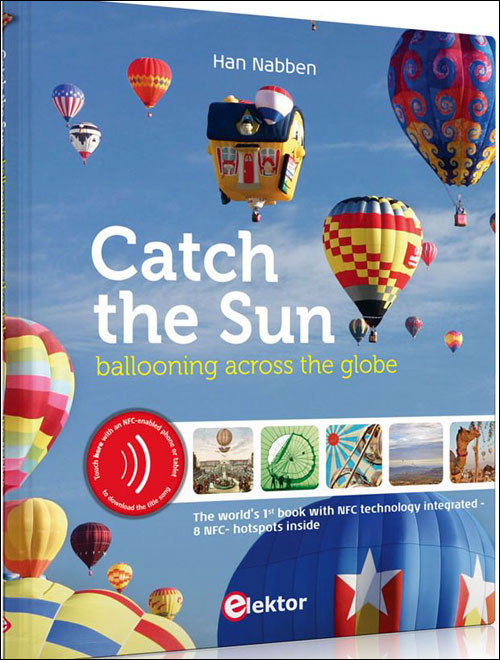Every year, Dutch publishing firm Elektor International Media produces 30 to 40 electronic and paper books, describing the use of technology. But this year, the company is releasing a book that actually incorporates some of that technology—specifically, Near Field Communication (NFC) RFID. Catch the Sun, a book about ballooning, is intended to bridge the traditional book-publishing world with the digital world, by featuring NFC tags on its cover and some of its pages. A user equipped with an NFC-enabled mobile phone or tablet can then tap each tag and be directed to an Elektor-hosted Web site in order to learn more about a particular topic. Those who buy the book can even personalize it, using the phone or tablet to encode two of its tags.
Han Nabben, the book’s author, is the senior director of integrated global marketing and communications at NXP Semiconductors, a company that manufactures a large percentage of the silicon chips used to produce NFC RFID tags. Nabben approached Wisse Hettinga, Elektor’s editor-in-chief, with an idea for a book about one of his favorite hobbies—ballooning—while incorporating NFC technology. “He was looking at what he does for business and pleasure, and how he could combine them,” Hettinga says.
Click here to view a larger version of the above cover.
The idea, Hettinga explains, gave Elektor an opportunity to connect the old technology of book publishing with the new technologies of NFC and the Internet.
The book utilizes a total of eight Identive Group NFC tags containing NXP NFC chips. A tag affixed to the cover provides a link to a Web page that downloads the book’s title song to the NFC-enabled phone or tablet. Five tags on the inside pages direct a user’s phone or tablet to a page on a Web site that provides additional information, pictures or videos about ballooning, or enables users to share the book with others via a social-media network, such as Facebook. And on the back cover are two tags that users can encode with their own information, such as a birthday greeting for a recipient of the book, information about their own ballooning experiences, or a link to another Web site of interest.
A user must have an NFC-enabled phone or tablet in order to access the additional content, but he or she need not download an application. Simply tapping the phone against the tag directs the device to the data specific to that tag’s unique ID number. Elektor set up a Web site on which it stores specific data related to each tag—as such, each tag sends a user to a different page on that site.
To program the two unencoded tags (labeled “make your own tag”), a user must download and install an app, such as NFC TagWriter, a free application created by NXP, though there are several others that would also work. The user would open the app and select “create and write,” and then enter the URL to which he or she would like to link that tag. Once this is done, anyone who taps the tag would automatically be directed to that particular URL. To input a text message, the user would select a prompt enabling that individual to input text that would then be displayed on the user’s NFC-enabled phone whenever someone read that tag.
The project posed several challenges, Hettinga says. Elektor had to conduct testing to ensure that the proper tag would be read, since all of a book’s tags are located in close proximity to one another. The company found, however, that if it spaced the tags apart so that each was embedded in a different area of a page, a phone would read the correct tag, and not one of the others in that book. He says that the Samsung Galaxy S3 phone Elektor used could easily interrogate any tags that it was placed against, he says, without capturing reads from other tags. For the book’s first print run, consisting of 1,000 copies, the publisher chose to manually apply the RFID tags by hand. However, Hettinga notes, in the future, the company plans to investigate how the tags could be applied to books automatically as part of the printing process.
Elektor is currently promoting the book on its own Web site, as well as with the ballooning industry. Hettinga says he also intends to share the results of the company’s work involving NFC technology with other book or magazine publishers. The tags, he adds, could be used for a variety of functions, including advertising.
A set of QR codes is printed at the back of the book, for those who lack an NFC-enabled smartphone or tablet. According to Elektor, the QR codes, when read by smartphone, allow a user to experience “most, but not all, of the multimedia dynamics of this book.” Although few mobile phones currently have NFC readers built into them, Hettinga says he expects that to change during the coming years, and he hopes to publish more books using NFC tags. For example, he adds, the company publishes books that provide instruction regarding programming or the use of specific software. With an NFC link, a user could then be directed to a specific site at which he or she could actually practice programming or using that software.
The book, which can be ordered at the Catch the Sun Web site, is priced at €45 ($57.50). A minimal amount of that cost, Hettinga notes, is related to the NFC technology.



